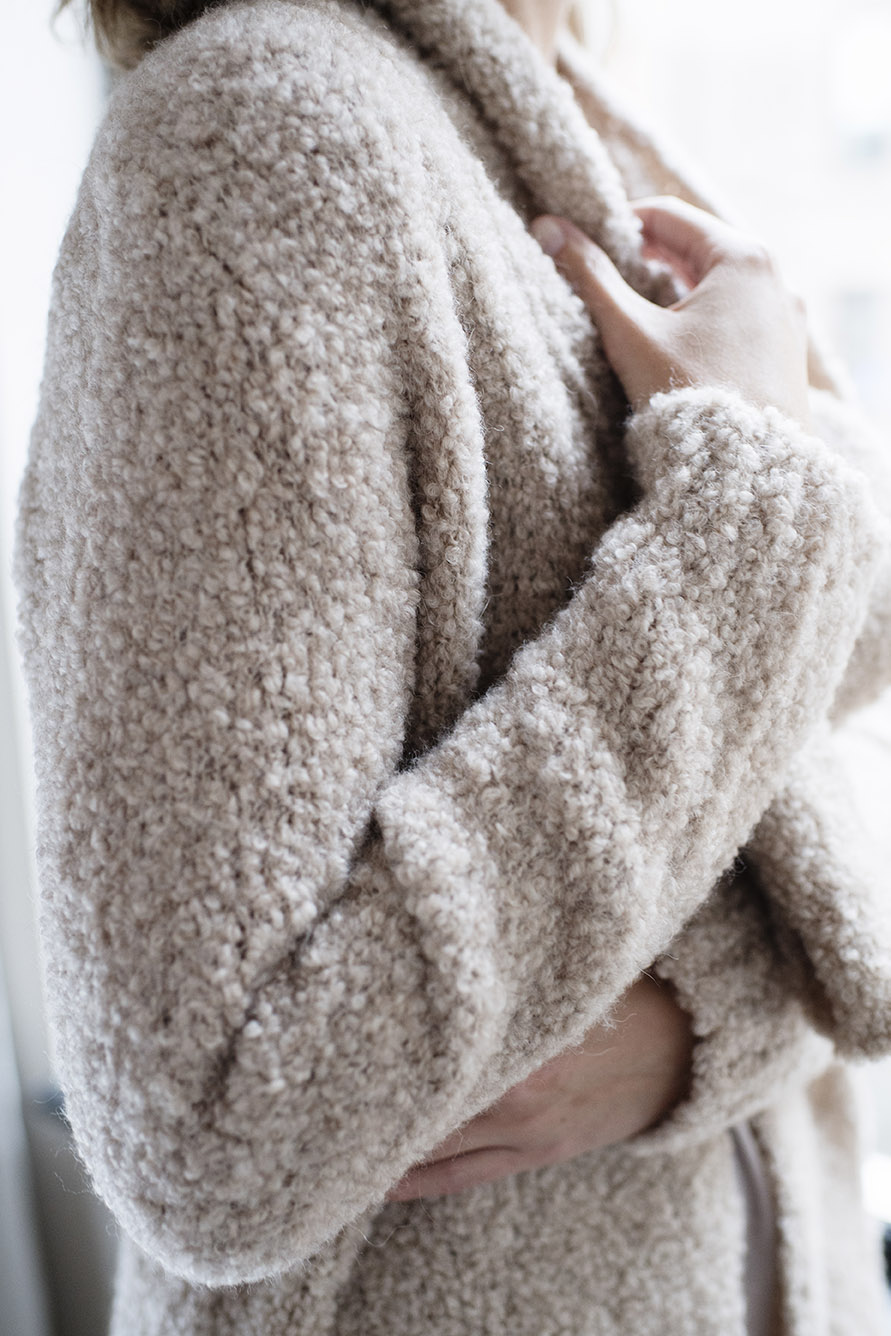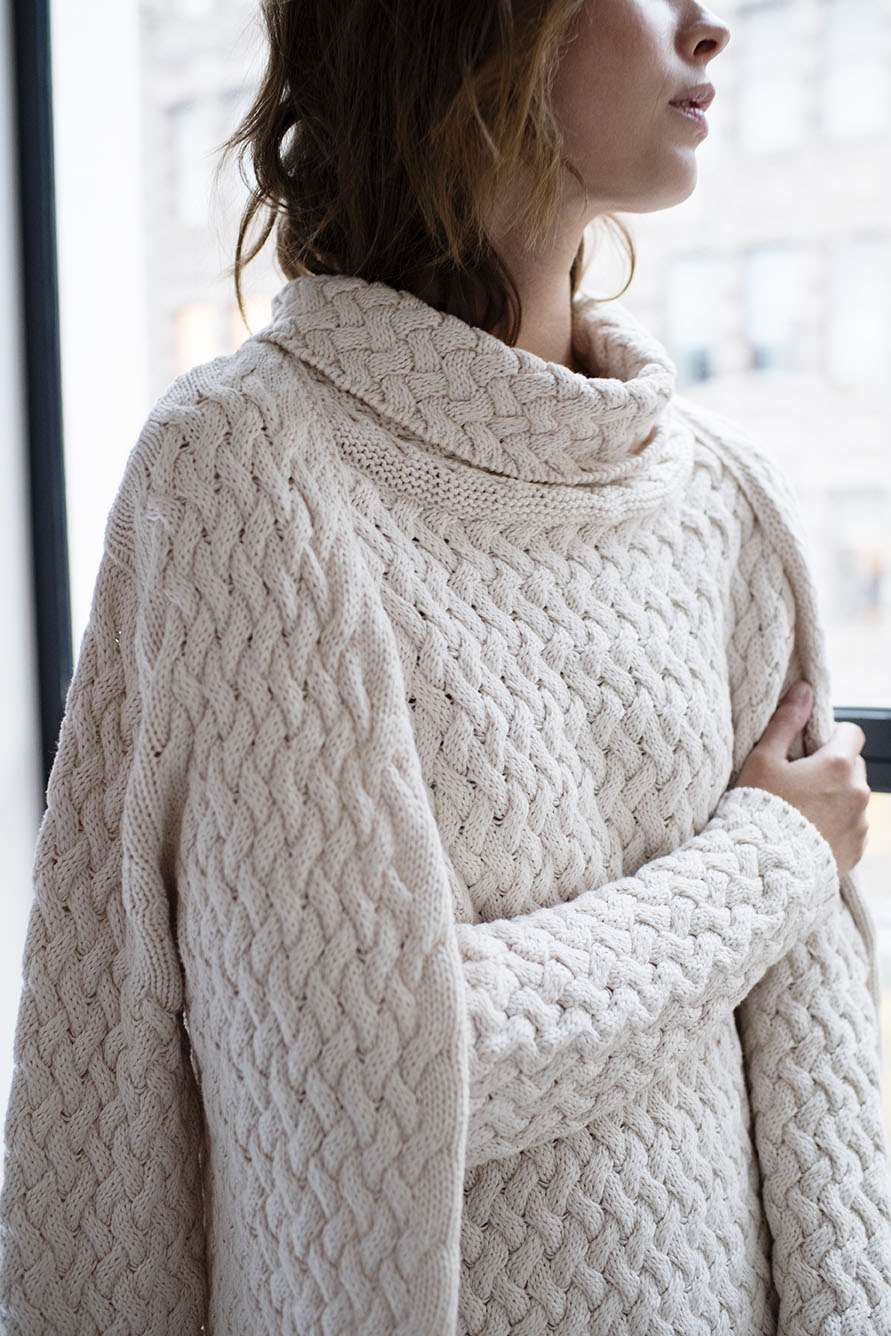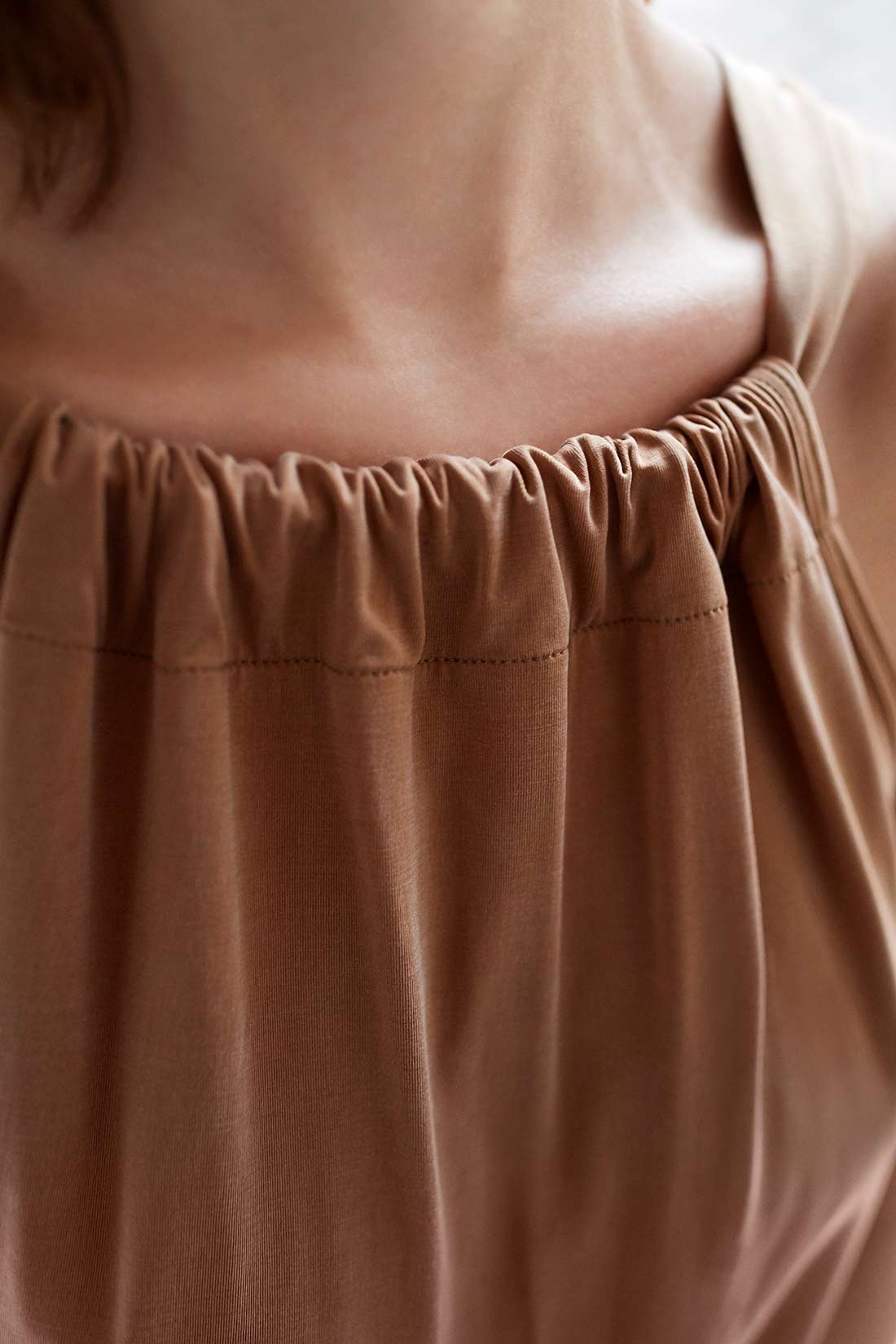
Mohair is made from the hair of the Angora goat. This goat is shaved twice a year.
Mohair
Mohair is one of the most sustainable wools. Clothing made of mohair is very durable as the fibres maintain their colour and do not pill. Another great benefit of mohair is its natural self-cleaning property. Because of this, most dirt can be removed simply by shaking out the item of clothing. For a deeper clean, you can ventilate your mohair item in the open air or steam it in your bathroom. This wool should be hand washed inside-out, using a mild detergent. Press out the water from the wool without wringing, lay flat to airdry.
- Wash mohair by hand, maximum of 30 degrees Celsius
- Wash the garment inside out
- Use a special wool detergent
- Never use a tumble dryer
- Dry the garmant flat
- Ironing is allowed at a low temperature, maximum of 110 degrees Celsius
Check the label of every article for specific washing instructions. Your clothing has been made with love and care and deserves the same treatment.
![]()

Mohair is made from the hair of the Angora goat. This goat is shaved twice a year.
Mohair
Mohair is one of the most sustainable wools. Clothing made of mohair is very durable as the fibres maintain their colour and do not pill. Another great benefit of mohair is its natural self-cleaning property. Because of this, most dirt can be removed simply by shaking out the item of clothing. For a deeper clean, you can ventilate your mohair item in the open air or steam it in your bathroom. This wool should be hand washed inside-out, using a mild detergent. Press out the water from the wool without wringing, lay flat to airdry.
- Wash mohair by hand, maximum of 30 degrees Celsius
- Wash the garment inside out
- Use a special wool detergent
- Never use a tumble dryer
- Dry the garmant flat
- Ironing is allowed at a low temperature, maximum of 110 degrees Celsius
Check the label of every article for specific washing instructions. Your clothing has been made with love and care and deserves the same treatment.
![]()
Alpaca wool comes from the alpaca. The alpaca is shaved once every three years.
Alpaca wool
This luxury wool is very soft and has a silky appearance. The wool has functional benefits: it regulates warmth, it keeps bad smells away, it is water repellent and it barely needs washing. Any creases will also disappear while wearing the item. In the unlikely event of deep creases, iron the wool on a low setting.
- Wash alpaca wool by hand, maximum of 30 degrees Celsius
- Wash the garment inside out
- Use a special wool detergent
- Never use a tumble dryer
- Dry the garment flat
- Ironing is allowed at a low temperature, maximum of 110 degrees Celsius
Check the label of every article for specific washing instructions. Your clothing has been made with love and care and deserves the same treatment.
![]()


Alpaca wool comes from the alpaca. The alpaca is shaved once every three years.
Alpaca wool
This luxury wool is very soft and has a silky appearance. The wool has functional benefits: it regulates warmth, it keeps bad smells away, it is water repellent and it barely needs washing. Any creases will also disappear while wearing the item. In the unlikely event of deep creases, iron the wool on a low setting.
- Wash alpaca wool by hand, maximum of 30 degrees Celsius
- Wash the garment inside out
- Use a special wool detergent
- Never use a tumble dryer
- Dry the garment flat
- Ironing is allowed at a low temperature, maximum of 110 degrees Celsius
Check the label of every article for specific washing instructions. Your clothing has been made with love and care and deserves the same treatment.
![]()

Linen is a textile made from the fibers of the flax plant.
Linen
Flax fibres are recyclable and decompose naturally. Our linen is dyed and the characteristic irregularities make each item unique. Linen will crease easily, so do not dry this material in the dryer. Ironing (on the inside, to reduce shine) works best when the textile is dampened by adding a little water or steam.
- Wash linen by hand, maximum of 30 degrees Celsius
- Use mild detergent
- Never use a tumble dryer
- Ironing is allowed on the inside of the fabric
Check the label of every article for specific washing instructions. Your clothing has been made with love and care and deserves the same treatment.
![]()

Linen is a textile made from the fibers of the flax plant.
Linen
Flax fibres are recyclable and decompose naturally. Our linen is dyed and the characteristic irregularities make each item unique. Linen will crease easily, so do not dry this material in the dryer. Ironing (on the inside, to reduce shine) works best when the textile is dampened by adding a little water or steam.
- Wash linen by hand, maximum of 30 degrees Celsius
- Use mild detergent
- Never use a tumble dryer
- Ironing is allowed on the inside of the fabric
Check the label of every article for specific washing instructions. Your clothing has been made with love and care and deserves the same treatment.
![]()
Cotton is a plant-based fibre, fabricated from the seeds of cotton plants.
Cotton
The seeds grow in a white, fluffy ball and are spun into yarn. Cotton is a firm textile with heat-resistant properties. Cotton can be washed in a washing machine, but repeated washing will eventually wear out the clothing and dull the colours of the fabric. The best way to rinse cotton clothing is to wash it by hand in lukewarm water with a minimal amount of detergent. Do not put your cotton items in the dryer, but let them air dry instead, avoiding exposure to direct sunlight.
- Wash cotton by hand, maximum of 30 degrees Celsius
- Use little detergent
- Never use a tumble dryer
- Ironing is allowed at a low temperature, maximum of 110 degrees Celsius
Check the label of every article for specific washing instructions. Your clothing has been made with love and care and deserves the same treatment.
![]()


Cotton is a plant-based fibre, fabricated from the seeds of cotton plants.
Cotton
The seeds grow in a white, fluffy ball and are spun into yarn. Cotton is a firm textile with heat-resistant properties. Cotton can be washed in a washing machine, but repeated washing will eventually wear out the clothing and dull the colours of the fabric. The best way to rinse cotton clothing is to wash it by hand in lukewarm water with a minimal amount of detergent. Do not put your cotton items in the dryer, but let them air dry instead, avoiding exposure to direct sunlight.
- Wash cotton by hand, maximum of 30 degrees Celsius
- Use little detergent
- Never use a tumble dryer
- Ironing is allowed at a low temperature, maximum of 110 degrees Celsius
Check the label of every article for specific washing instructions. Your clothing has been made with love and care and deserves the same treatment.
![]()

Cupro is a natural, high quality product, made with cellulose from plant-based sources.
Cupro
This cellulose is artificially derived from wood, mainly spruces, pine trees and beech trees. Cupro soaks up moisture, which makes the material drip-dry. This material is smooth, light and breathable and, furthermore, hypoallergenic. We recommend dry cleaning all Cupro clothing, but if you would prefer to clean an item yourself, wash in cold water and avoid wringing. Hang to dry.
- Wash cupro by hand, maximum of 30 degrees Celsius
- Use a mild detergent
- Never use a tumble dryer
- Ironing is allowed at a low temperature, maximum of 110 degrees Celsius
Check the label of every article for specific washing instructions. Your clothing has been made with love and care and deserves the same treatment.
![]()

Cupro is a natural, high quality product, made with cellulose from plant-based sources.
Cupro
This cellulose is artificially derived from wood, mainly spruces, pine trees and beech trees. Cupro soaks up moisture, which makes the material drip-dry. This material is smooth, light and breathable and, furthermore, hypoallergenic. We recommend dry cleaning all Cupro clothing, but if you would prefer to clean an item yourself, wash in cold water and avoid wringing. Hang to dry.
- Wash cupro by hand, maximum of 30 degrees Celsius
- Use a mild detergent
- Never use a tumble dryer
- Ironing is allowed at a low temperature, maximum of 110 degrees Celsius
Check the label of every article for specific washing instructions. Your clothing has been made with love and care and deserves the same treatment.
![]()
Viscose is derived from wood pulp, straw and cotton linters of the cotton plant.
Viscose
Viscose can be hand washed at a maximum of 30 degrees. At higher temperatures, the fabric can shrink. Use a mild detergent. Viscose is more fragile when wet, so never rub or brush the item when washing by hand. Lay the items flat to dry; this protects the shape of the clothing and minimises creasing.
- Wash viscose by hand, maximum of 30 degrees Celsius
- Use a mild detergent
- Never use a tumble dryer
- Dry the garment flat
- Ironing is allowed at a low temperature, maximum of 110 degrees Celsius
Check the label of every article for specific washing instructions. Your clothing has been made with love and care and deserves the same treatment.
![]()


Viscose is derived from wood pulp, straw and cotton linters of the cotton plant.
Viscose
Viscose can be hand washed at a maximum of 30 degrees. At higher temperatures, the fabric can shrink. Use a mild detergent. Viscose is more fragile when wet, so never rub or brush the item when washing by hand. Lay the items flat to dry; this protects the shape of the clothing and minimises creasing.
- Wash viscose by hand, maximum of 30 degrees Celsius
- Use a mild detergent
- Never use a tumble dryer
- Dry the garment flat
- Ironing is allowed at a low temperature, maximum of 110 degrees Celsius
Check the label of every article for specific washing instructions. Your clothing has been made with love and care and deserves the same treatment.
![]()

Merino wool comes from the merino sheep in Australia. This wool variety is soft and flexible, yet firm and resilient.
Merino wool
One of merino wool’s great benefits is its self-cleaning property. This wool does not require frequent washing, so only wash your item when necessary. Always wash by hand only and use a special wool detergent. Lay the clothing flat to air dry. Warning: this wool will shrink in the dryer!
- Wash merino wool by hand, maximum of 30 degrees Celsius
- Wash the garment inside out
- Use a special wool detergent
- Never use a tumble dryer
- Dry the garment flat
- Ironing is allowed at a low temperature, maximum of 110 degrees Celsius
Check the label of every article for specific washing instructions. Your clothing has been made with love and care and deserves the same treatment.
![]()

Merino wool comes from the merino sheep in Australia. This wool variety is soft and flexible, yet firm and resilient.
Merino wool
One of merino wool’s great benefits is its self-cleaning property. This wool does not require frequent washing, so only wash your item when necessary. Always wash by hand only and use a special wool detergent. Lay the clothing flat to air dry. Warning: this wool will shrink in the dryer!
- Wash merino wool by hand, maximum of 30 degrees Celsius
- Wash the garment inside out
- Use a special wool detergent
- Never use a tumble dryer
- Dry the garment flat
- Ironing is allowed at a low temperature, maximum of 110 degrees Celsius
Check the label of every article for specific washing instructions. Your clothing has been made with love and care and deserves the same treatment.
![]()
Silk is obtained from the cocoons of the silkworm.
Silk
This fabric has versatile properties: silk is warm and cosy in winter, yet cooling when temperatures rise. Although silk is known as a firm textile, it can be quite vulnerable during maintenance. Wash silk by hand, at a maximum of 30 degrees. Use a detergent for delicates. Rinse well and do not let the fabric soak. Press out the water carefully without wringing. Silk should be ironed on the reverse side of the fabric, preferably while still damp.
- Wash silk by hand, maximum of 30 degrees Celsius
- Use a mild detergent
- Never use a tumble dryer
- Be careful with jewellery and other sharp objects that could scratch or tear the garment
- Ironing is allowed at a low temperature, maximum of 110 degrees Celsius
It is important to consult the care label on each garment for specific cleaning instructions.
Please treat your clothing with the same love and care as it was created with.
![]()


Silk is obtained from the cocoons of the silkworm.
Silk
This fabric has versatile properties: silk is warm and cosy in winter, yet cooling when temperatures rise. Although silk is known as a firm textile, it can be quite vulnerable during maintenance. Wash silk by hand, at a maximum of 30 degrees. Use a detergent for delicates. Rinse well and do not let the fabric soak. Press out the water carefully without wringing. Silk should be ironed on the reverse side of the fabric, preferably while still damp.
- Wash silk by hand, maximum of 30 degrees Celsius
- Use a mild detergent
- Never use a tumble dryer
- Be careful with jewellery and other sharp objects that could scratch or tear the garment
- Ironing is allowed at a low temperature, maximum of 110 degrees Celsius
It is important to consult the care label on each garment for specific cleaning instructions.
Please treat your clothing with the same love and care as it was created with.
![]()